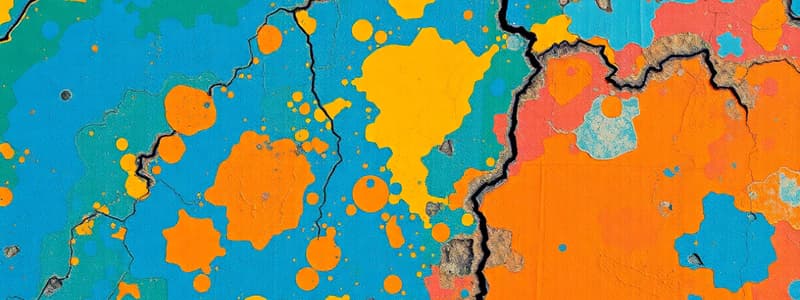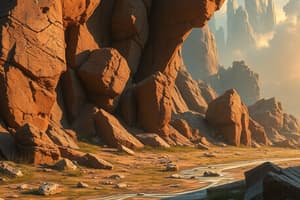Podcast
Questions and Answers
Thermal expansion, where temperature changes cause rocks to expand and contract, is considered a form of chemical weathering.
Thermal expansion, where temperature changes cause rocks to expand and contract, is considered a form of chemical weathering.
False (B)
During frost weathering, the expansion of water as it freezes within rock cracks contributes to the process of ice wedging.
During frost weathering, the expansion of water as it freezes within rock cracks contributes to the process of ice wedging.
True (A)
Exfoliation occurs when increased pressure from overlying materials causes the outer layers of rock to peel and break away.
Exfoliation occurs when increased pressure from overlying materials causes the outer layers of rock to peel and break away.
False (B)
Abrasion, a component of mechanical weathering, involves the chemical decomposition of rocks through exposure to acidic solutions.
Abrasion, a component of mechanical weathering, involves the chemical decomposition of rocks through exposure to acidic solutions.
In chemical weathering, the decomposition of original materials always precedes the formation of secondary materials, regardless of environmental conditions.
In chemical weathering, the decomposition of original materials always precedes the formation of secondary materials, regardless of environmental conditions.
Rocks that are consistently shielded from atmospheric exposure tend to weather at a faster rate than those directly exposed.
Rocks that are consistently shielded from atmospheric exposure tend to weather at a faster rate than those directly exposed.
Rocks composed of minerals that exhibit high reactivity with water and oxygen typically demonstrate slower weathering rates compared to rocks with inert minerals.
Rocks composed of minerals that exhibit high reactivity with water and oxygen typically demonstrate slower weathering rates compared to rocks with inert minerals.
Warm, arid climates encourage higher rates of rock weathering compared to cold, humid climates.
Warm, arid climates encourage higher rates of rock weathering compared to cold, humid climates.
Soil is a static medium composed solely of sediment and minerals, lacking any biological components.
Soil is a static medium composed solely of sediment and minerals, lacking any biological components.
Soils with a granular structure are typically unsuitable for growing fruits and vegetables.
Soils with a granular structure are typically unsuitable for growing fruits and vegetables.
The lowermost layer of a soil profile, situated beneath any soil horizons, is known as the leaching zone.
The lowermost layer of a soil profile, situated beneath any soil horizons, is known as the leaching zone.
Soil erosion is more prevalent in areas with dense vegetation cover due to increased soil disturbance.
Soil erosion is more prevalent in areas with dense vegetation cover due to increased soil disturbance.
Tilling fields and removing plant stalks in winter can help prevent soil erosion.
Tilling fields and removing plant stalks in winter can help prevent soil erosion.
Planting shelterbelts and practicing contour farming can help prevent soil erosion.
Planting shelterbelts and practicing contour farming can help prevent soil erosion.
Mass wasting describes the transport of sediments downslope solely through wind action, independent of water content or seismic activity.
Mass wasting describes the transport of sediments downslope solely through wind action, independent of water content or seismic activity.
Flashcards
Weathering
Weathering
The breakdown of rocks on Earth's surface.
Mechanical Weathering
Mechanical Weathering
Physical breakdown of rocks into smaller pieces.
Frost Weathering (Ice Wedging)
Frost Weathering (Ice Wedging)
Water freezes in cracks, expands, and breaks rocks.
Exfoliation
Exfoliation
Signup and view all the flashcards
Abrasion
Abrasion
Signup and view all the flashcards
Minerals
Minerals
Signup and view all the flashcards
Soil definition
Soil definition
Signup and view all the flashcards
Soil Sediments
Soil Sediments
Signup and view all the flashcards
Soil structure types
Soil structure types
Signup and view all the flashcards
Soil erosion
Soil erosion
Signup and view all the flashcards
Shelterbelt
Shelterbelt
Signup and view all the flashcards
No-till farming
No-till farming
Signup and view all the flashcards
Terracing
Terracing
Signup and view all the flashcards
Mass wasting
Mass wasting
Signup and view all the flashcards
Study Notes
- Weathering is the process of breaking down rocks on Earth's surface.
- The two main types of weathering are mechanical and chemical.
Mechanical Weathering
- Breaks down rocks by physical means into smaller pieces.
- Examples include:
- Thermal expansion: Temperature changes cause rocks to expand and contract.
- Frost weathering (ice wedging): Water freezes in rock cracks, expands, and enlarges the cracks.
- Exfoliation: Outer rock layers peel away as pressure lessens from above.
- Abrasion: Rocks collide and scrape against each other due to wind, ice, water, and gravity.
- Salt Crystal Growth: Salt crystals grow in rock cracks after water evaporates, pushing the rock apart.
Biological Weathering
- Weathering of rock caused by living organisms.
- Plants, animals, fungi, and microorganisms can mechanically and/or chemically weather rock.
- Mechanical, biological, and chemical weathering occur simultaneously.
Chemical Weathering
- Takes on many forms: acidification, carbonation, hydrolysis, oxidation and the impact from living organism.
- It is a slow process.
- The process depends on the chemical process and material hardness and environment.
- Chemical weathering process consists of decomposition of original materials and formation of secondary materials.
- Warm and cold climates impact the chemical processes.
- Enhanced by geological agents (water and oxygen).
- Enhanced by acids created by biological agents (roots, microbial organisms).
Factors Affecting Weathering Rate
- Exposure to the atmosphere accelerates weathering.
- Rock composition: Reactive minerals weather faster.
- Softer and porous rocks weather more rapidly.
- Climate: Warm, humid climates increase weathering rates.
Soil Composition
- Soil is a mixture of:
- Sediment and minerals
- Organic matter
- Gases and liquids
- Organisms and microorganisms
- Provides essential ecosystem and life support for plants.
- Develops through weathering, erosion, deposition, and organic matter contribution from pioneer species.
- Consists of sand, silt, clay, or loam.
- Soil particulates form granular, platy, or columnar structures.
- Granular soil is best for growing fruits and vegetables.
- Soil profiles have horizons (layers) with varying sediment types.
- Topsoil has the most organic matter, deeper layers have more clay and silt, and bedrock lies beneath.
Soil Erosion
- Wind, water, or gravity move soil.
- Exposed soil is more prone to erosion.
- Heavily tilled soil erodes more easily than soil with vegetation.
- Eroded topsoil reduces soil quality and crop yields, and washes away seeds/small plants.
- Eroded soil carries fertilizers/pesticides, causing water pollution.
- The USDA offers incentives for erosion prevention.
- Best practices include:
- Planting shelterbelts (windbreaks)
- Preventing overgrazing
- Employing no-till farming
- Planting cover crops
- Using mulch or soil matting
- Strip cropping and terracing
- Contour farming
- Crop rotation
Sediment Deposition and Mass Wasting
- Stability disruption due to water/seismic activity causes downslope sediment transport (mass wasting) that is due to gravity.
- Types of mass wasting:
- Slumps: Slow, short-distance downslope movement of semi-consolidated material.
- Rockslides: Destructive, large-area sliding of rocks (rock avalanches).
- Debris flow: Downslope motion of broken rock and soil fragments facilitated by high water saturation (fluid flow).
- Earthflow: Flow of mud-sized material, losing shear strength due to high water saturation.
- Creep: Very slow downslope movement.
- Mudflows: Rapid downslope movement associated with volcanic eruptions, mixing pyroclastic material and water.
- Mass wasting affects roads, buildings, pipelines, etc.
- Mitigation strategies:
- Improve water drainage.
- Slope stabilization.
- Build blockages and fences.
- Increase vegetation for soil anchoring.
Mass Wasting (General)
- Large downward movement of rock, soil, geologic materials, and debris due to gravity.
- Types include landslides, rock avalanches, and slumps.
- Shear strength is the resistive force holding land together (gravity and friction).
- Mountains have more shear strength than sand dunes.
Factors Triggering Mass Wasting:
- Increased precipitation: Saturates slopes and washes away soil.
- Loss of vegetation: Reduces soil anchoring and protection.
- Earthquakes: Decrease shear force.
- High slope steepness: Increases gravitational pull.
Negative Impacts of Mass Wasting:
- Harm to human and animal life.
- Damage to homes, cars, and infrastructure.
- Reduced property values and tourism.
Types of Mass Wasting (Specific)
- Slump: Sliding of rock material along a curved surface; rotational slide.
- Rockslide: Sliding of rock material down a mountain along a pre-existing plane; translational slide.
- Debris flow: Rapid movement of water-laden mud, sand, soil, rock, and debris.
- Earthflow: Slow flow of fine-grained material, often hourglass-shaped.
Rock Deformation
- Rocks deform (change size/shape) due to stress.
- Types of stress:
- Tensional: Stretching apart.
- Compressional: Pushing together.
- Shear: Horizontal slippage.
Phases of Deformation:
- Elastic: Reversible deformation.
- Ductile: Irreversible deformation without breaking.
- Fracture: Irreversible breaking.
Factors Affecting Rock Response to Stress:
- Material: Ductile rocks flow, brittle rocks break.
- Temperature and water: Heat and water increase elasticity; cool and dry increase brittleness.
Studying That Suits You
Use AI to generate personalized quizzes and flashcards to suit your learning preferences.
Description
Weathering breaks down rocks on Earth's surface. Mechanical weathering involves physical processes like thermal expansion and frost wedging. Biological weathering is caused by living organisms, while chemical weathering alters the rock's composition.




